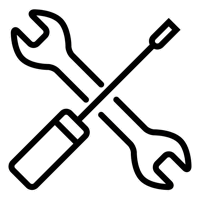Cable Locators
BYDA-Compliant Radiodetection Cable Locators
Cable locators are critical tools for safe excavation, construction, and utility maintenance. At Testrix, we specialise in supplying Radiodetection locators, the global standard for underground service detection. Our range includes the latest RD7200, RD8200, MRX, MRX G, and MRX SG models – each designed to deliver accuracy, reliability, and BYDA compliance.
When digging or drilling, striking an unknown buried service can cause costly delays, dangerous accidents, and expensive repairs. Radiodetection cable locators prevent these risks by providing precise detection of underground assets such as power cables, gas lines, water mains, and telecommunications infrastructure.
Cable Locator Applications by Industry
- Contractors & Civil Works: Trace utilities before excavation to avoid strikes and penalties.
- Utilities & Councils: Locate and maintain essential infrastructure with confidence.
- Telecommunications: Identify and map buried fibre and copper networks.
- Surveyors & Engineers: Conduct asset surveys and prepare accurate site plans.
Why Choose Radiodetection Locators from Testrix?
- BYDA Compliance: Ensure your projects meet “Before You Dig Australia” requirements.
- Advanced Technology: From entry-level models to GPS-enabled MRX systems with centimetre accuracy.
- Training & Support: Testrix provides expert hands-on training and local technical backup.
- Trusted Supplier: Supplying contractors, utilities, and councils across Australia.
Our cable locating equipment is available with finance options for qualifying purchases, fast Australia-wide delivery, and ongoing service support. Testrix is more than just a supplier – we’re your partner in safe excavation and professional service locating.
Explore the full range of Radiodetection cable locators today and work with confidence on every project.
FAQ's
What is the easiest way to find underground pipes?
The easiest way to find underground pipes is with an underground cable & pipe locator. These offer a reliable and fast way to detect and locate pipes and other buried services without the need to dig. For general locating work, the Radiodetection RD7200 offers a precise and easy solution to this application and can locate a wide range of buried services and utilities from pipes to telecoms and power cables. For pipes which are non-metallic such as PVC or concrete pipes, a rodder and sonde such as the Flexitrace allows the locating equipment to find these types of pipes. For general avoidance, rather than precise locating, the Radiodetection CAT4+ or gCAT4+ will provide a more cost-effective solution if you are merely trying to avoid pipes and cables. This equipment works by using a signal transmitter to apply a signal (called a locate signal) to the underground pipe or utility and then tracing and pinpointing that signal with the locator. You will be able to identify the position and the depth of the pipe. It is worth noting that the locator alone is not sufficient and must be used with a suitable transmitter. Testrix Systems can provide advice and equipment to meet these requirements to ensure that you don’t end up with the wrong equipment.
What does a pipe locator do?
A Radiodetection pipe locator detects and traces the path of underground pipes by receiving signals applied to them. In simple terms, it shows you where a pipe runs and how deep it is buried, when used with a suitable transmitter, which applies a frequency onto the line so it can be picked up by the receiver above ground. The Radiodetection RD8200SG is one of the most advanced pipe locators on the market, offering multiple frequencies, depth readings, current measurement, and GPS mapping to ensure highly accurate surveys. In practice, a pipe locator is an essential tool for anyone digging, trenching, or carrying out civil works, as it eliminates the guesswork and helps prevent service strikes.
How do you trace an underground water pipe?
The process for tracing underground water pipes varies, depending on which material the pipe is made from. Metallic pipes, such as copper and steel can be traced using a traditional locator system, such as the Radiodetection CAT4+, RD7200 or even the RD8200 and above. With the transmitter, a signal is applied at a set frequency, and the locator is used to pinpoint the position and depth of the pipe. For non-metallic pipes such as plastic, the process is a little different. If there is access to the inside of the pipe, then a rodder and sonde, such as the Radiodetection Flexitrace can be used to provide a signal for the locator to detect, but if the pipe cannot be accessed, for example a plastic water pipe under mains pressure, then a dedicated plastic pipe locator, such as the Radiodetection RD510 can be used for this purpose. The technology is different as it uses an acoustic method rather than the electromagnetic method used with the traditional locators, but it does give the ability to trace plastic water pipes. In conclusion the method and equipment is based on the pipe’s material.
What is the use of cable locator?
A cable locator is used to detect and trace the position of underground power cables and other buried services before excavation, or for mapping of buried services. It helps contractors, electricians, and councils avoid striking live cables, which can cause serious injury, outages, or expensive damage. Radiodetection cable locators, such as the RD7200 and RD8200, are designed to give highly accurate depth and position readings. Some cable locators offer survey accurate GPS positioning, for example the RD8200SG and the MRXSG for accurate mapping of buried utilities for inclusion into professional survey reports. When paired with a transmitter like the TX5, TX10 or TX10B, they can apply a signal directly onto the cable for fast and reliable detection. In practice, a cable locator is an essential safety and productivity tool on any job site where digging or trenching takes place.
How deep can cable locators detect?
The depth a cable locator can detect depends on the model, soil conditions, and how the signal is applied. Radiodetection cable locators are capable of detecting buried cables at depths of up to 6 metres in ideal conditions when used with the appropriate transmitter. In real-world applications, most contractors will reliably trace services between 1–3 metres deep, which covers the majority of underground electrical and communication cables. Depth accuracy is a key feature of the RD7200 and RD8200, which provide continuous depth readouts and current measurements to verify you are following the correct cable, even in congested areas.
What's the best type of cable detector?
The best type of cable detector is one that combines accuracy, durability, and ease of use. For professional users in Australia, Radiodetection locators are considered the industry standard. The RD7200 is an excellent all-round unit for water authorities, electricians, and contractors who need reliable daily locating. For more advanced work, the RD8200 adds features like multiple locate modes, depth and current measurement, GPS logging, and Bluetooth connectivity for reporting. The RD8200SG couples precise and accurate service locating with cm accurate GPS which is essential for professional locating companies, where the exact position of a buried service must be mapped for inclusion into professional reports. The Radiodetection MRX range couple cable and pipe locating with the ability to precisely locate buried RF marker balls and pins, and are suitable for undertaking the BYDA (Before You Dig Australia) practical accreditation. All models are built to withstand tough site conditions and are backed by global support, which makes them the best choice for contractors who can’t afford mistakes when locating underground cables.




























